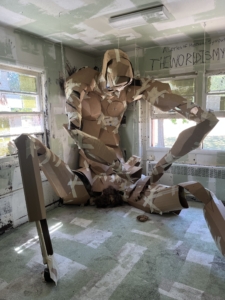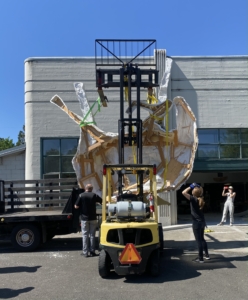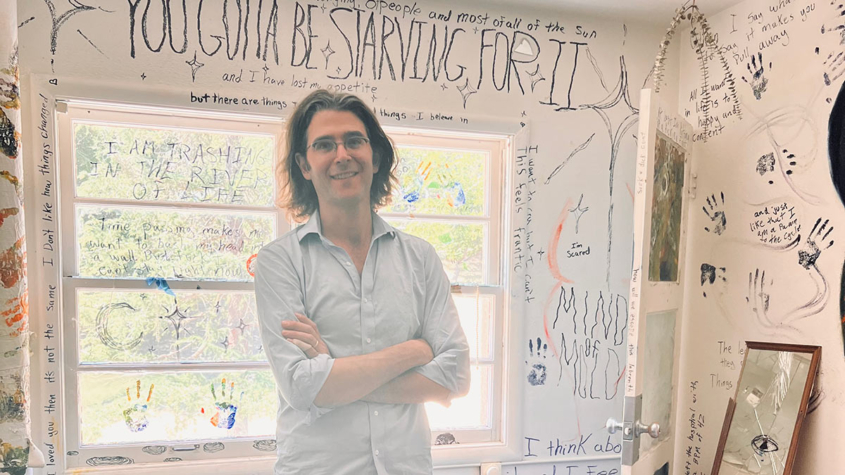The convivial artist: engaged teaching & art with Michael Parker
Michael Parker is no ordinary teacher and no ordinary artist. In fact, his enthusiasm for teaching socially engaged art is exhilarating. His teaching philosophy resonates with students as it’s situated in the relational and the inspired, which is what many young artists are looking for when entering the arts discipline in college. Since his arrival at Southern Oregon University, Parker has worked diligently to galvanize active art practices on the SOU campus.
Paulo Freire, the great Brazilian philosopher and educator, wrote, “The more radical the person is, the more fully he or she enters into reality so that, knowing it better, he or she can transform it. This individual is not afraid to confront, to listen, to see the world unveiled.”
 Parker adheres to this kind of philosophy – in teaching and art – by unveiling the inventive possibility of art and sculpture at SOU.
Parker adheres to this kind of philosophy – in teaching and art – by unveiling the inventive possibility of art and sculpture at SOU.
“Sculpture is not only objects – it can be anywhere, anything,” Parker says. “It can be an idea, a digital application, a performance, a moment of calm looking at something. It’s about asking questions.”
Born in New York City in 1978, Parker graduated from Pomona College with a bachelor’s degree in 2000, and earned an a master of fine arts degree in New Genres from the Roski School of Art at the University of Southern California in 2009. After many years of teaching and practicing art in Los Angeles, he took a position at SOU in 2019 and is now an associate professor of sculpture. Parker lives in Ashland with his wife, Alyse Emdur, who is also an artist, and their young child.
His ambitious socially and materially engaged art practice revolves around cooperation and collaboration. His practice is born from conceptual art, sculpture history and relational aesthetics.
“These shifts relate to my broader interest in the relationship between moments of interpersonal exchange and collective action,” Parker says.
His work includes “Lineman,” a series of photographs, videos, and audio interviews presented in several choreographies and arrangements, culminating in a 60-page printed broadside. The 50 participants – all linemen – invited Parker into their lineman training program at LA Trade Tech College. Parker also created the “Steam Egg,” which was inspired by his post-grad fellowship into utopian communities.
After traveling to several communities around the world, he created a three-legged, bottom-entry mirrored steam room (now patented), which seats up to eight participants in its hollow core. Finally, he choreographed a collaborative dig along the Los Angeles River to unveil a 137-foot-long recumbent obelisk, which recreated the excavation site of Hatshepushut’s “Unfinished Obelisk,” circa 1463 BCE. The process included permissions from government agencies, GIS surveys, soil testing, ground penetrating radar and ultimately 40 participants trying their hand at using earthmoving equipment to complete the dig.
 Parker has brought this collaborative sensibility to SOU. Since his arrival on campus, he’s re-energized the sculpture program by coordinating and creating three very important projects. In 2022, Parker envisioned a temporary sculpture garden outside the DeBoer Sculpture Building on Siskiyou Boulevard, on land that had been underused and overgrown. In partnership with the Schneider Museum, they broke ground in the spring of 2023 and the Mary Campagna Sculpture Garden was reborn, effectively creating a new public face of the creative arts at SOU.
Parker has brought this collaborative sensibility to SOU. Since his arrival on campus, he’s re-energized the sculpture program by coordinating and creating three very important projects. In 2022, Parker envisioned a temporary sculpture garden outside the DeBoer Sculpture Building on Siskiyou Boulevard, on land that had been underused and overgrown. In partnership with the Schneider Museum, they broke ground in the spring of 2023 and the Mary Campagna Sculpture Garden was reborn, effectively creating a new public face of the creative arts at SOU.
Parker, working with SOU Facilities, designed and installed three concrete pads, specified to different measurements, bolt patterns, and orientations. This temporary sculpture garden is ephemeral, with its next phase of landscaping occurring in the fall of 2023. Student work is displayed, and most recently, Parker’s creation for “Art Beyond” was exhibited there – an installation made of 100,000 worms, an insulated plinth, salvaged sink, solar pump and redwood.
“The rafted sink will spend a day in a local waterway followed by a procession of performative mourners,” he says of the installation. “Join us for an experimental group cry.”
Though much contemporary art doesn’t always “look” like art, Parker’s commitment to empowering young people with skill is vital to his theories of allowing for softness to develop in the work of younger artists while also supplying them with technical knowledge. Parker’s life sculpture course from winter 2023 doubled down on the importance and breadth of historical training and methods by working with a live model, oil and water-based clay. Before this, during the pandemic, Parker made 35 material demonstration training videos for wood, plaster, clay, mold-making and metals, and they are now available as an Open Educational Resource.
In addition to the new sculpture garden, Parker has recently started an artist-run-space, Suzy Two, in underused dorm rooms in SOU’s Suzanne Holmes Hall. The first iteration was part of an Honors College special offering in fall of 2022. It was so popular that Parker held a second course in the spring of 2023 and will offer a third version this fall. With Parker’s leadership and vision, the dorms were transformed with student art.
The students produced two ‘zines’ of the work, including written and photographic documentation. Some of the works include “Distance from Necessity,” by Josie Bolstad, which explores human basic needs in the form of mirrors, figures and discarded materials. “Pony in a Pit” by Chella Maize is another installation in which salvaged bedfoam was made into a horse from Emile Zola’s 1885 novel “Germinal.” The sun rises over the horse, and on the summer solstice, Chella read from the novel as the sunlight streamed into the room.
Parker has forged a partnership with Recology in Ashland to design a one-of-a-kind, Artist-in-Residency program specifically for students. Student artists apply and then earn a stipend while creating art with materials gleaned from the Valley View Transfer Station. This program began in January 2023, with the first cohort creating a diverse set of artworks displayed in the CVA Galleries. SOU’s Digital Cinema program produced several documentaries about the process. Applications for the year-long cohort will open again this fall term. Listen to Parker, with BFA alumna Chella Maize, discuss the project on JPR’s Jefferson Exchange here.
As Parker develops this contemporary art practice on SOU’s campus, he’s also advancing his teaching by participating in a “Humane Leadership” course taught by Stephen Sloan with the Local Innovation Lab offered through the Center for Teaching and Learning at SOU. He was invited with five faculty and three students to participate in this inaugural program.
“This gave me the opportunity to have cross-disciplinary conversation with leaders from across our community in a myriad of different positions,” Parker says of the program and how he’ll apply what he learns. “This provided insight to my own role as a leader and the reality of leadership potential, which I know I will carry with me for years to come.”
Parker’s offers a teaching philosophy intended to inspire: “Helping younger artists is very much a part of my practice as both a teacher and as an artist,” he says. “How can I empower students to be fully agented humans, and how can I support them to be actively engaged with their community through art? These are the questions that drive me.”
Story by Melissa Matthewson, SOU Director of Development Communications



